
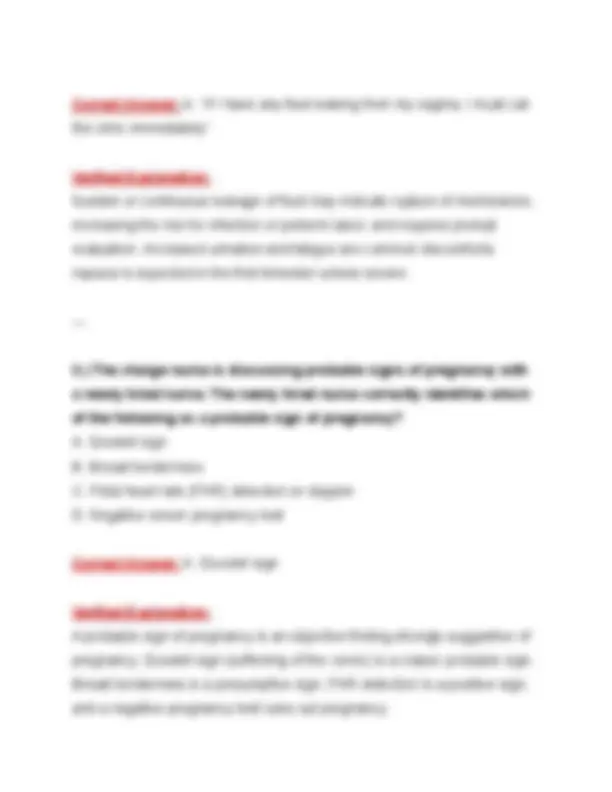
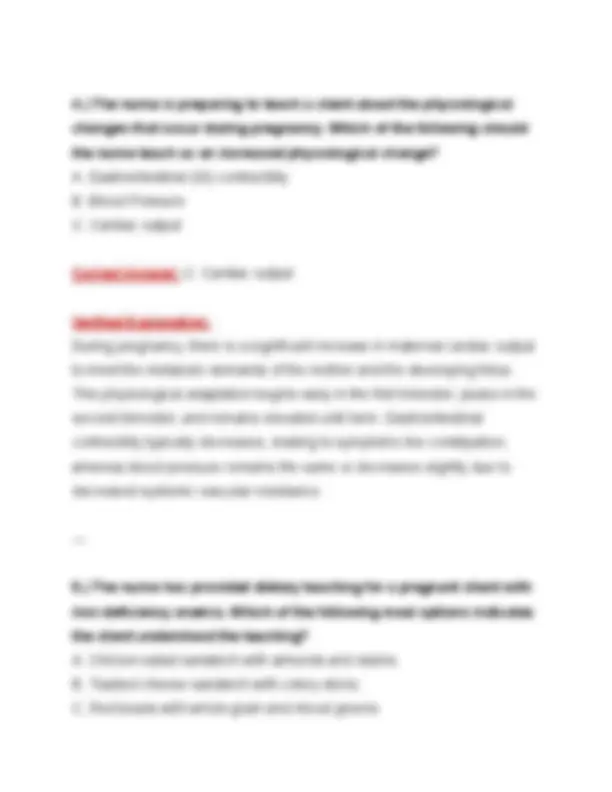
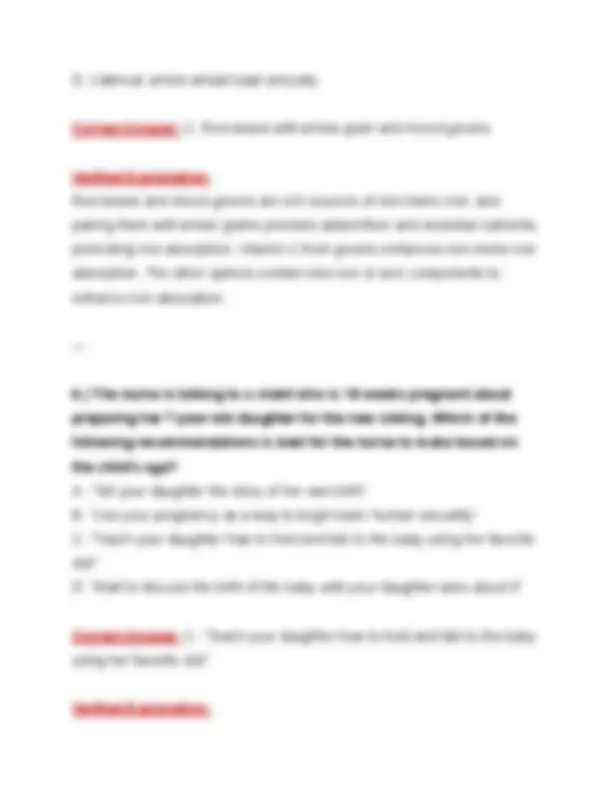
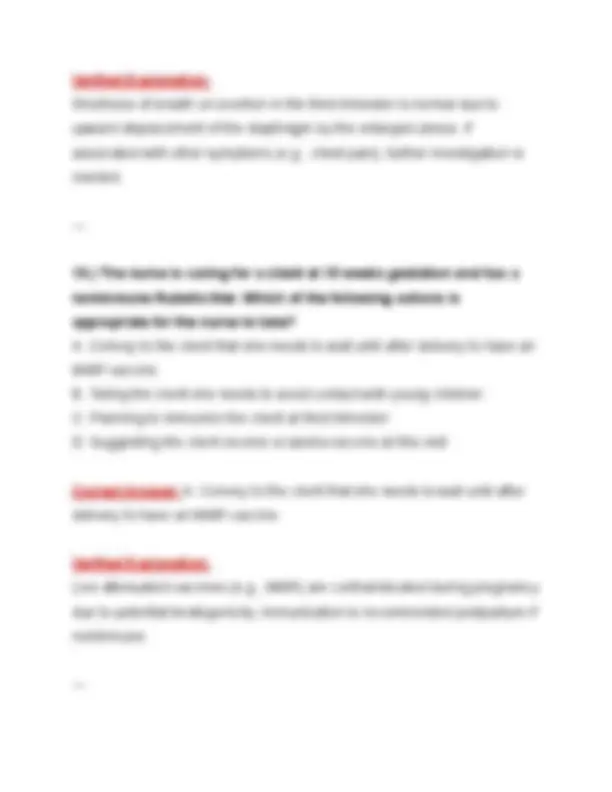
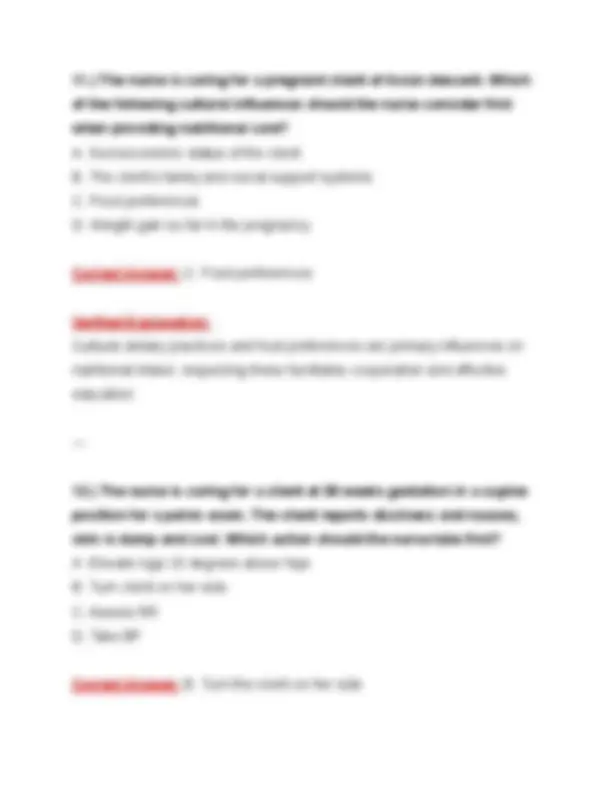
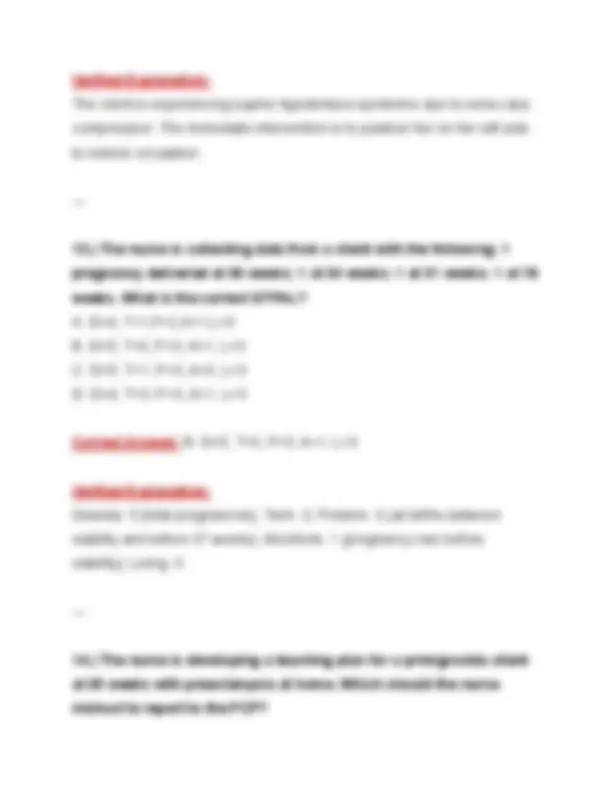
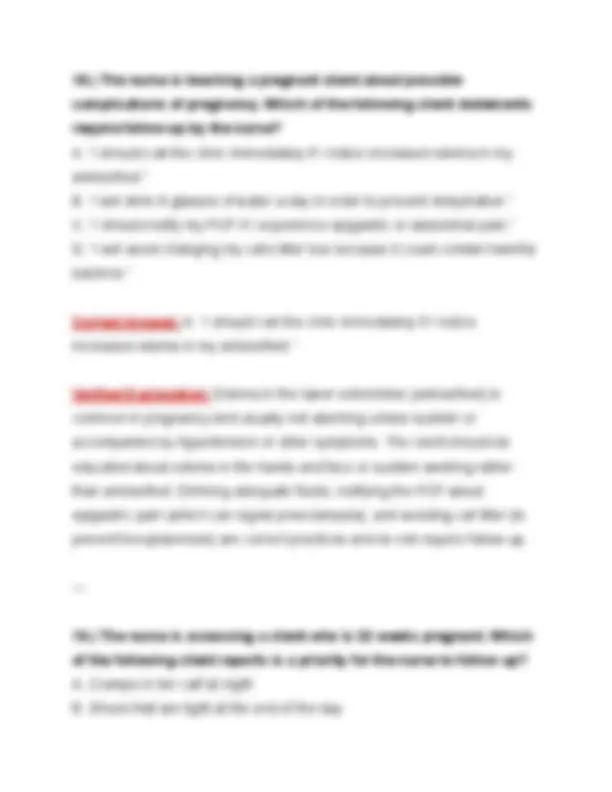
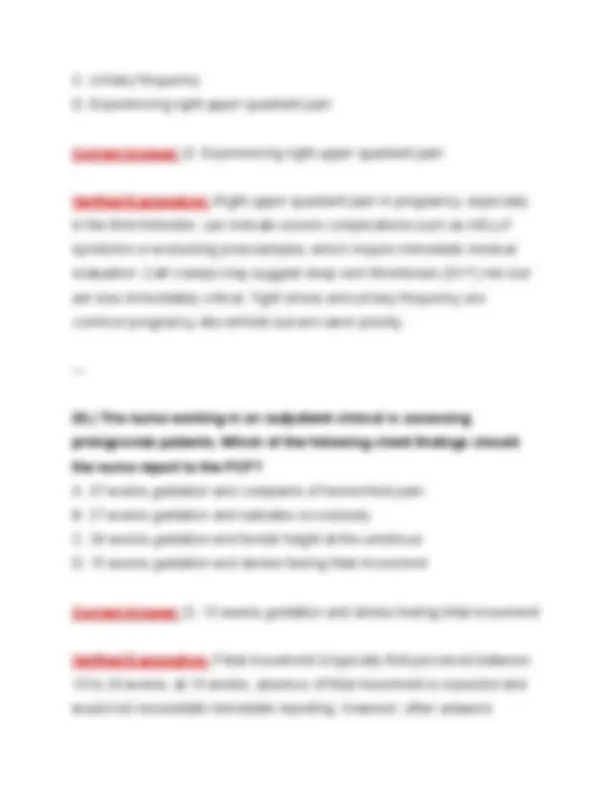
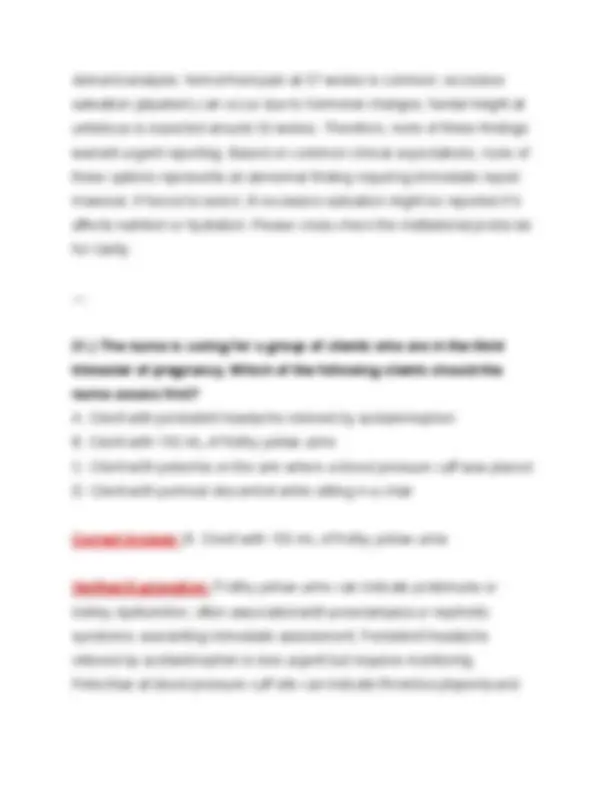
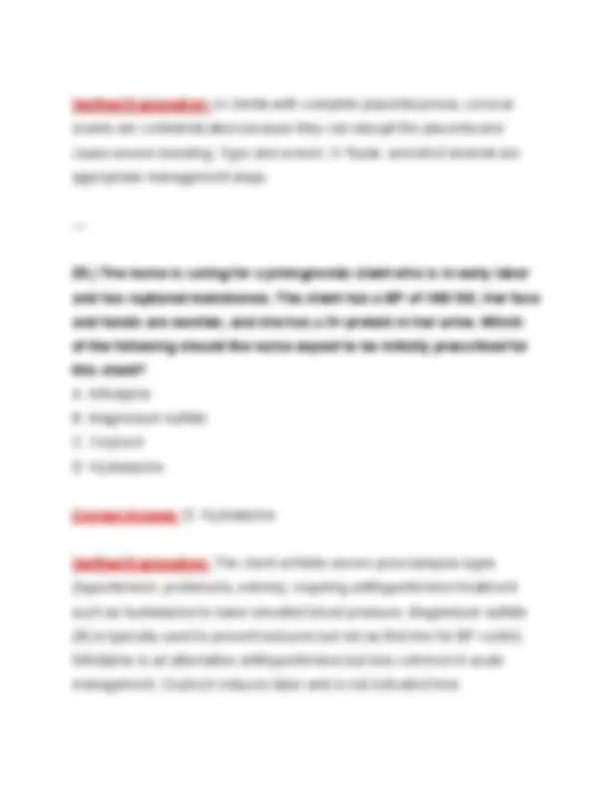
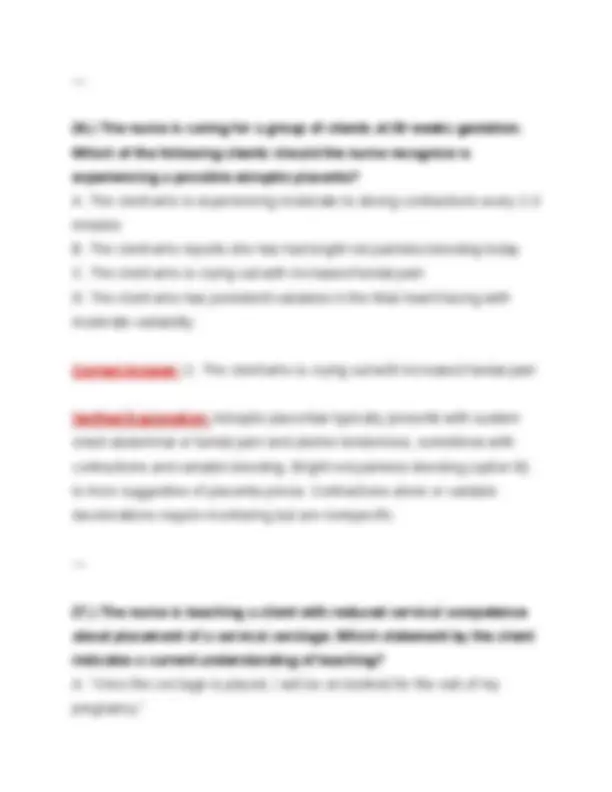
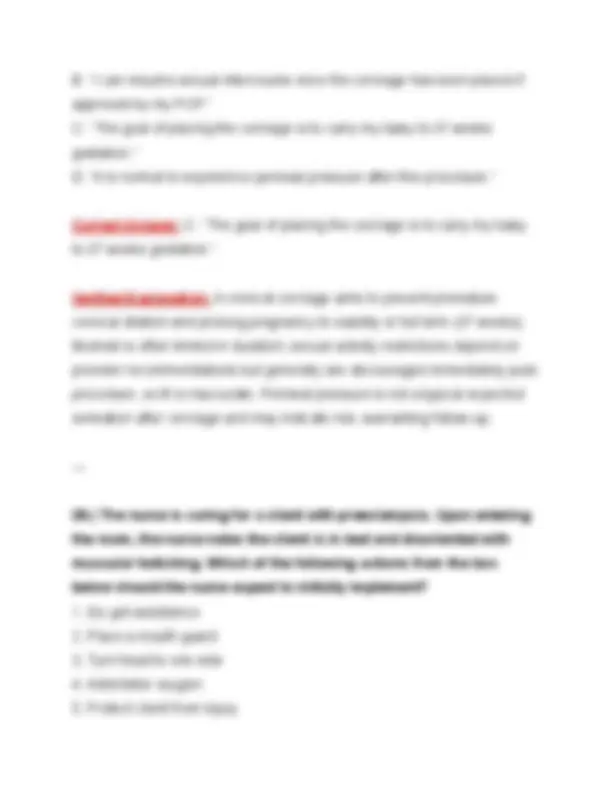
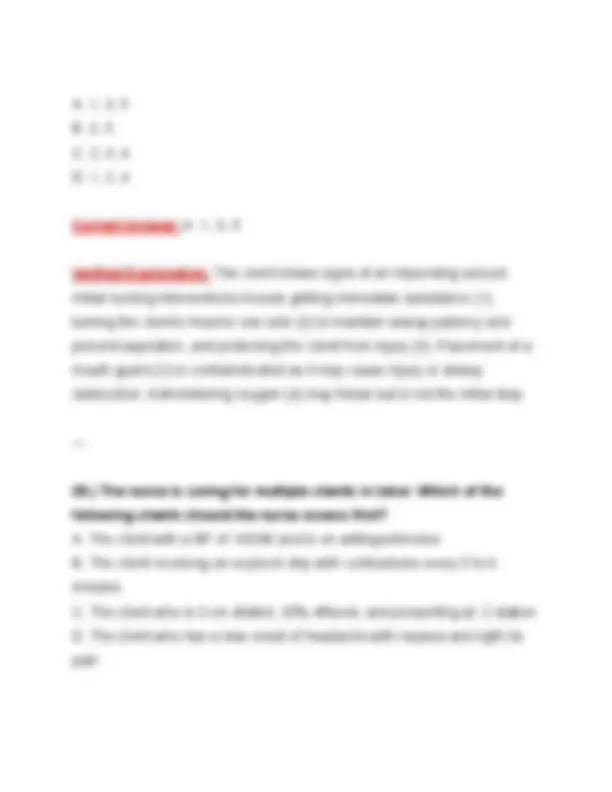
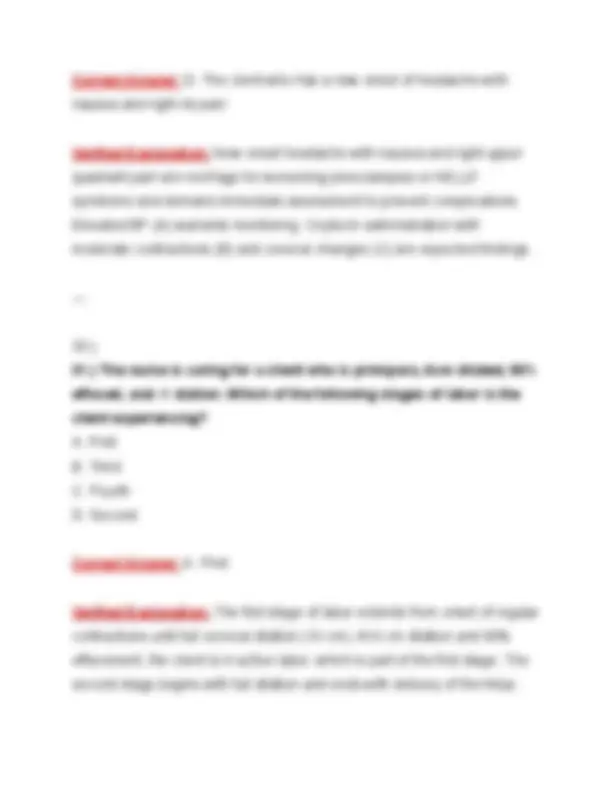
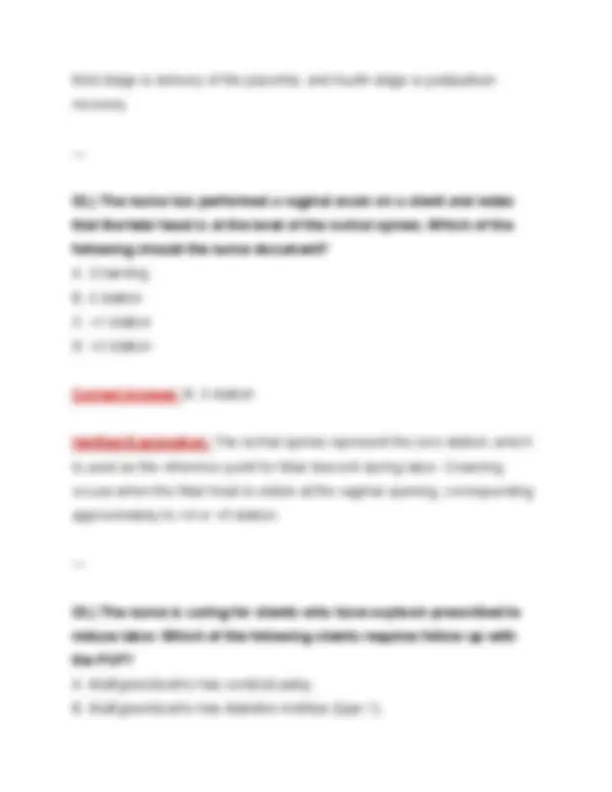
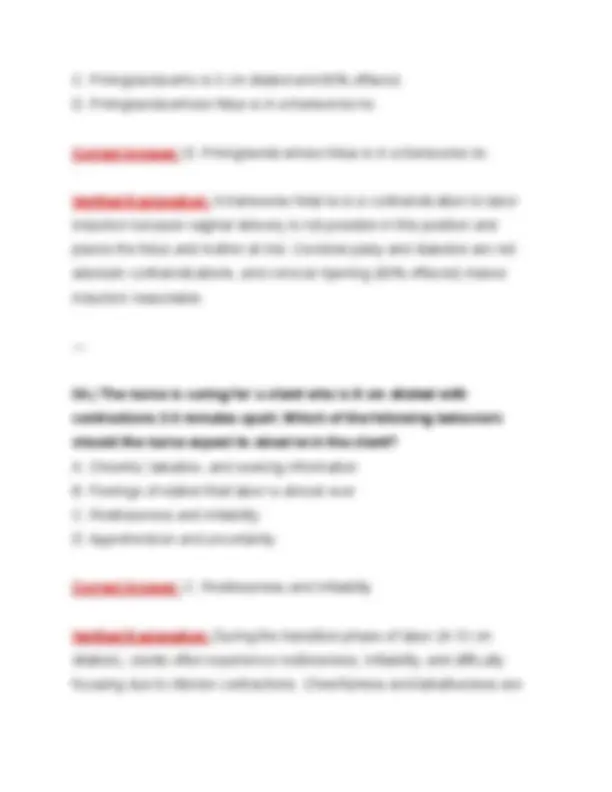
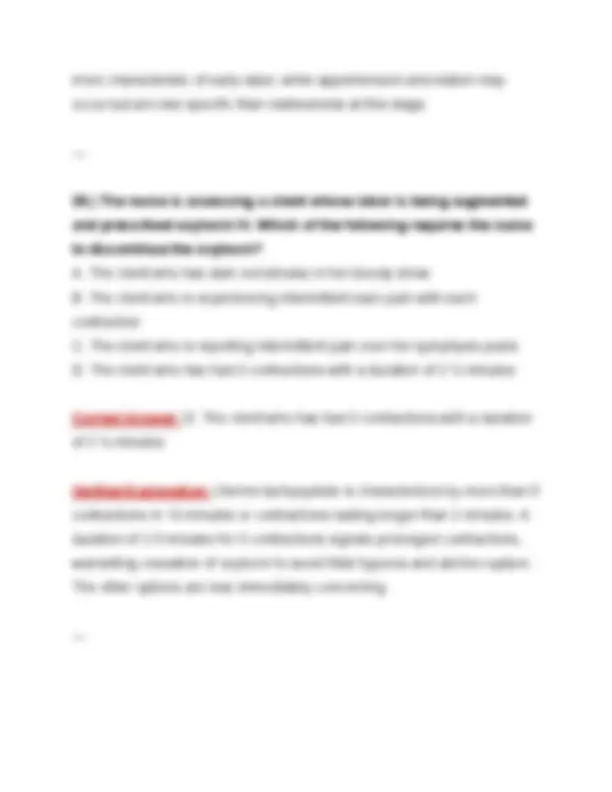
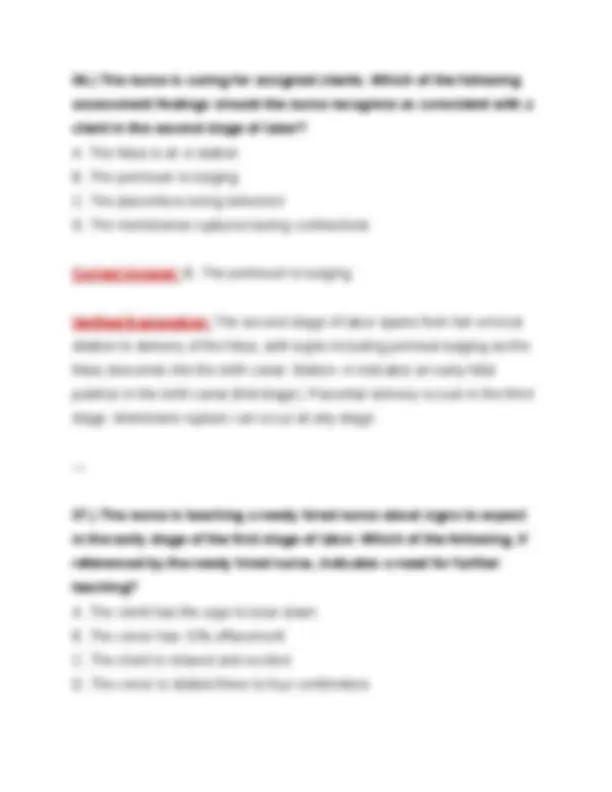
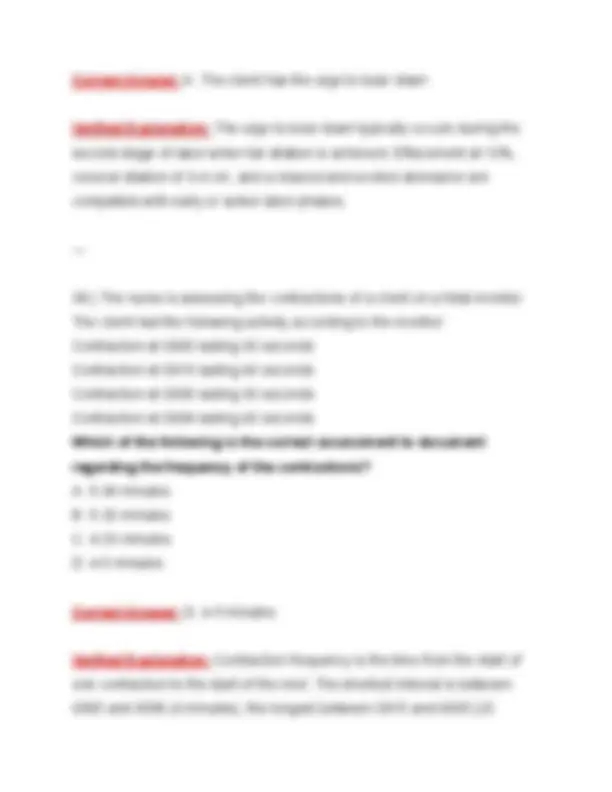
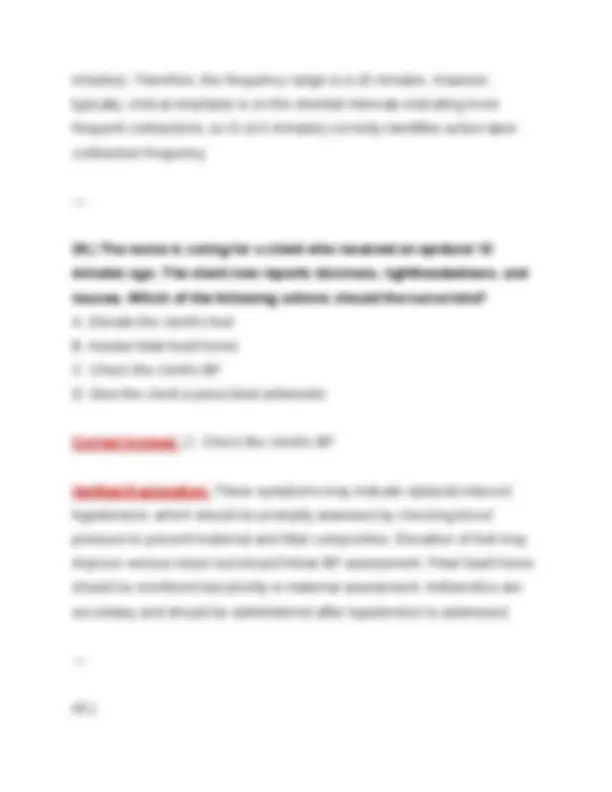
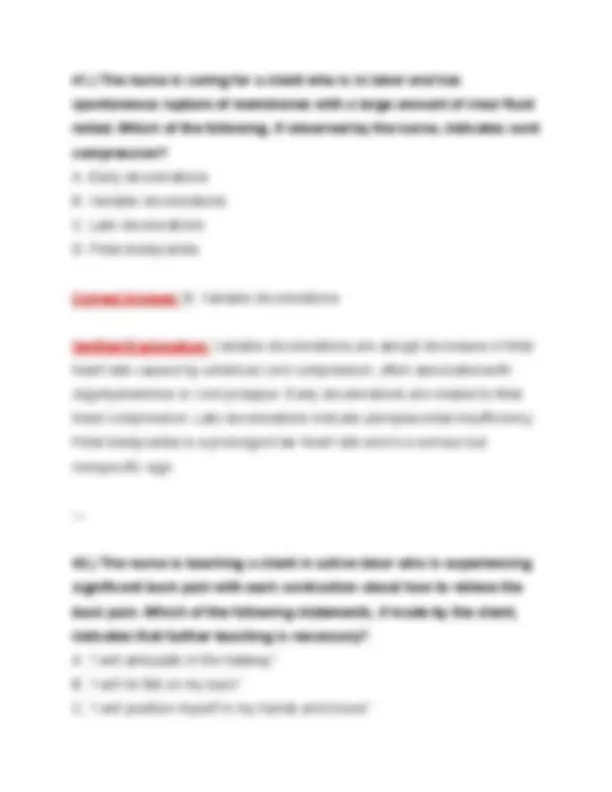
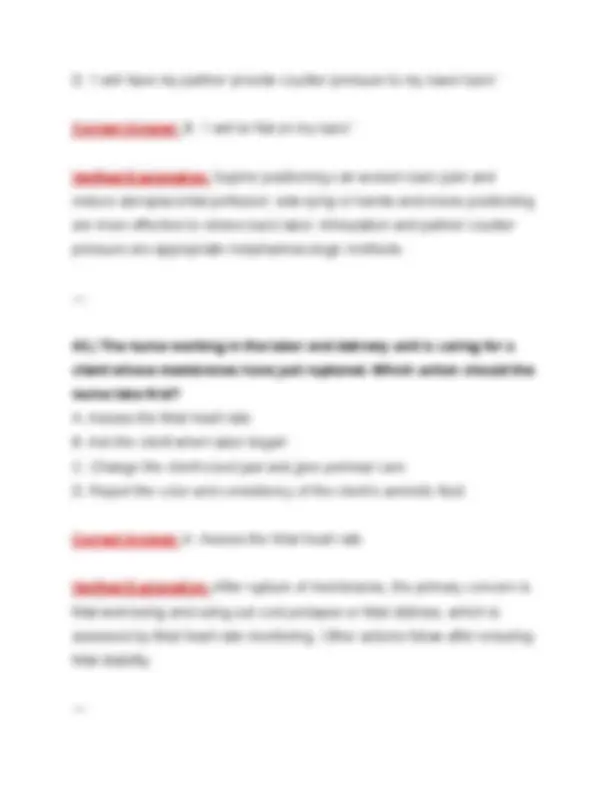
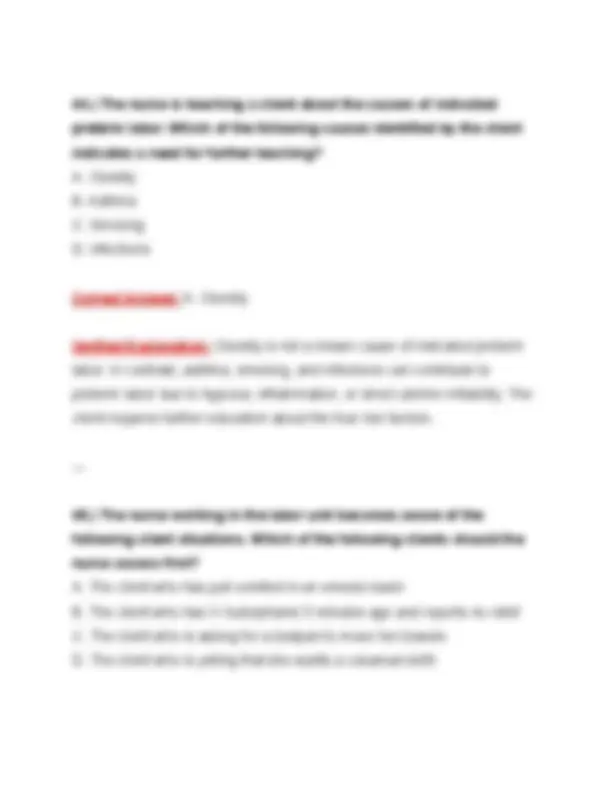
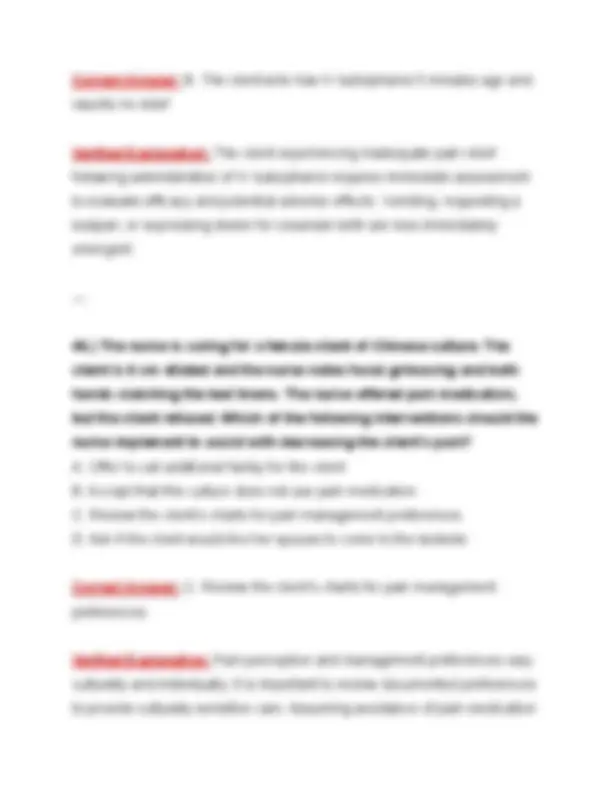
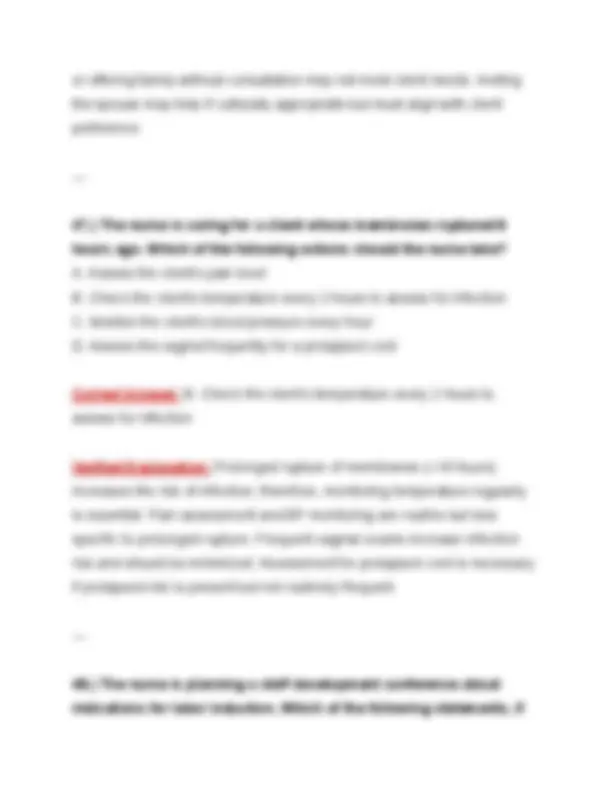
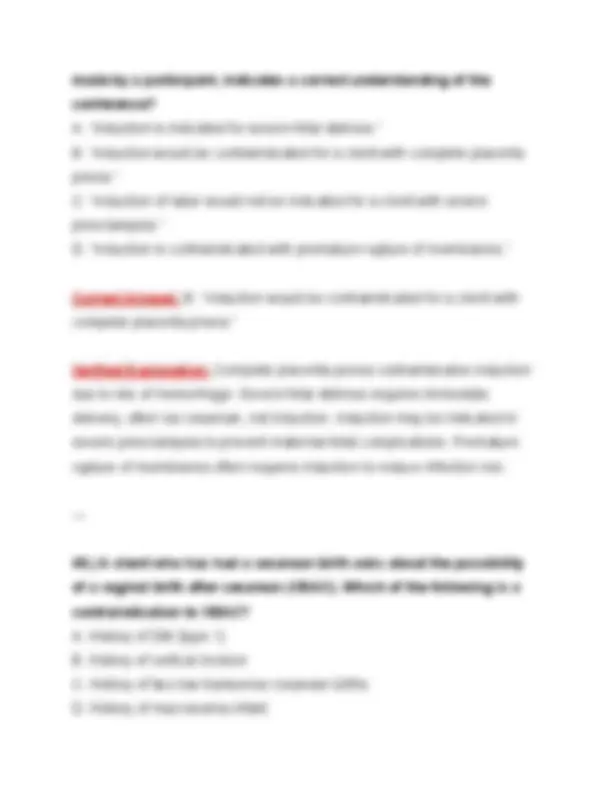
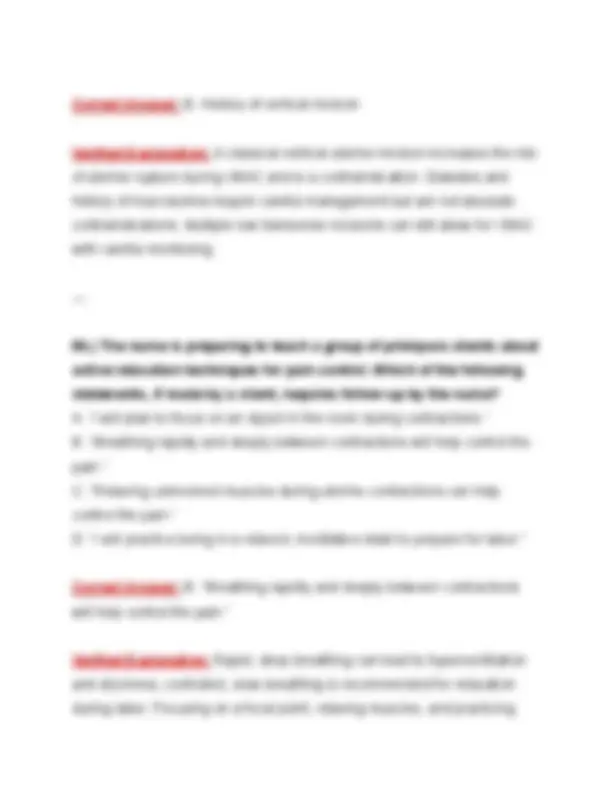



Study with the several resources on Docsity

Earn points by helping other students or get them with a premium plan


Prepare for your exams
Study with the several resources on Docsity

Earn points to download
Earn points by helping other students or get them with a premium plan
Community
Ask the community for help and clear up your study doubts
Discover the best universities in your country according to Docsity users
Free resources
Download our free guides on studying techniques, anxiety management strategies, and thesis advice from Docsity tutors
INSTANT DOWNLOAD PDF — NUR 254 Exam 1 from Galen College of Nursing provides 50 actual multiple-choice questions and expert-verified answers covering Maternal and Pediatric Nursing topics. Each answer includes in-depth rationales to reinforce learning and boost clinical reasoning. Guaranteed pass material for nursing students preparing for academic success. NUR 254 Exam 1, Galen College of Nursing, maternal and pediatric nursing, nursing exam pdf, nursing questions and answers, verified nursing test, NCLEX-style questions, prenatal nursing exam, OB nursing questions, pediatric nursing quiz, test bank Galen, nursing study guide, nursing multiple choice test, nursing exam answers, clinical nursing questions, download nursing exam, study guide PDF nursing, maternity nursing prep, nursing test bank 2024, exam practice nursing, nursing school help, actual exam questions, rationales for nursing exam, guaranteed pass nursing, nursing pdf resource
Typology: Exams
1 / 36

This page cannot be seen from the preview
Don't miss anything!





























➢ Actual 50 Questions and Answers ➢ 100% Guarantee Pass. ➢ Multiple-Choice (A–D). ➢ Each Question Includes The Correct Answer ➢ Expert-Verified explanation is essential in solidifying your understanding and pinpointing weak areas.
1 .) The nurse is teaching a client who is in the 10th week of pregnancy about morning sickness. Which of the following should the nurse include in the teaching? A) Avoid all fluids during meals to prevent nausea B) Eat small, frequent meals throughout the day C) Increase intake of spicy and fatty foods to settle the stomach D) Take antiemetic medication immediately upon waking Correct Answer: B) Eat small, frequent meals throughout the day Verified Explanation: The nurse should teach the client to eat small, frequent meals, avoid spicy and fatty foods, keep crackers at bedside to eat before rising, stay hydrated, and avoid an empty stomach. Ginger and vitamin B6 may help, and severe vomiting (hyperemesis gravidarum) should be reported.
2 .) The nurse is teaching a client about symptoms to report during her pregnancy. Which of the following statements by the client indicates a correct understanding of the teaching? A. “If I have any fluid leaking from my vagina, I must call the clinic immediately” B. “I’ll report increased frequency of urination” C. “Nausea should be reported immediately” D. “If I feel tired after resting, I should report it immediately”
4 .) The nurse is preparing to teach a client about the physiological changes that occur during pregnancy. Which of the following should the nurse teach as an increased physiological change? A. Gastrointestinal (GI) contractility B. Blood Pressure C. Cardiac output Correct Answer: C. Cardiac output Verified Explanation: During pregnancy, there is a significant increase in maternal cardiac output to meet the metabolic demands of the mother and the developing fetus. This physiological adaptation begins early in the first trimester, peaks in the second trimester, and remains elevated until term. Gastrointestinal contractility typically decreases, leading to symptoms like constipation, whereas blood pressure remains the same or decreases slightly due to decreased systemic vascular resistance.
5 .) The nurse has provided dietary teaching for a pregnant client with iron deficiency anemia. Which of the following meal options indicates the client understood the teaching? A. Chicken salad sandwich with almonds and raisins. B. Toasted cheese sandwich with celery sticks. C. Red beans with whole-grain and mixed greens
D. Oatmeal, whole wheat toast and jelly. Correct Answer: C. Red beans with whole-grain and mixed greens Verified Explanation: Red beans and mixed greens are rich sources of non-heme iron, and pairing them with whole grains provides added fiber and essential nutrients, promoting iron absorption. Vitamin C from greens enhances non-heme iron absorption. The other options contain less iron or lack components to enhance iron absorption.
6.) The nurse is talking to a client who is 18 weeks pregnant about preparing her 7-year-old daughter for the new sibling. Which of the following recommendations is best for the nurse to make based on the child’s age? A. “Tell your daughter the story of her own birth” B. “Use your pregnancy as a way to begin basic human sexuality” C. “Teach your daughter how to hold and talk to the baby using her favorite doll” D. “Wait to discuss the birth of the baby until your daughter asks about it” Correct Answer: C. “Teach your daughter how to hold and talk to the baby using her favorite doll” Verified Explanation:
8.) The nurse is caring for a pregnant client who is recently diagnosed with pica. Which of the following Hgb levels should the nurse expect to find in the client’s chart? A. 16g/dL B. 8g/dL C. 12 g/dL D. 20 g/dL Correct Answer: B. 8g/dL Verified Explanation: Pica is associated with iron deficiency anemia. Normal Hgb in pregnancy is
11g/dL; 8g/dL reflects significant anemia.
9.) The nurse is caring for a primigravida in her third trimester and is experiencing SOB when walking up stairs. Which of the following statements by the nurse is appropriate? A. ”You will feel much better once lightening occurs” B. “You should immediately report this difficulty breathing to your PCP” C. “If you lie on your left side, it will relieve your SOB” D. “This would be considered normal during this stage of pregnancy” Correct Answer: D. “This would be considered normal during this stage of pregnancy”
Verified Explanation: Shortness of breath on exertion in the third trimester is normal due to upward displacement of the diaphragm by the enlarged uterus. If associated with other symptoms (e.g., chest pain), further investigation is needed.
10.) The nurse is caring for a client at 15 weeks gestation and has a nonimmune Rubella titer. Which of the following actions is appropriate for the nurse to take? A. Convey to the client that she needs to wait until after delivery to have an MMR vaccine B. Telling the client she needs to avoid contact with young children C. Planning to immunize the client at third trimester D. Suggesting the client receive a rubella vaccine at this visit Correct Answer: A. Convey to the client that she needs to wait until after delivery to have an MMR vaccine Verified Explanation: Live attenuated vaccines (e.g., MMR) are contraindicated during pregnancy due to potential teratogenicity. Immunization is recommended postpartum if nonimmune.
Verified Explanation: The client is experiencing supine hypotensive syndrome due to vena cava compression. The immediate intervention is to position her on her left side to restore circulation.
13.) The nurse is collecting data from a client with the following: 1 pregnancy delivered at 36 weeks; 1 at 34 weeks; 1 at 31 weeks; 1 at 18 weeks. What is the correct GTPAL? A. G=4, T=1,P=2,A=1,L= B. G=5, T=0, P=3, A=1, L= C. G=5, T=1, P=3, A=0, L= D. G=4, T=0, P=3, A=1, L= Correct Answer: B. G=5, T=0, P=3, A=1, L= Verified Explanation: Gravida: 5 (total pregnancies); Term: 0; Preterm: 3 (all births between viability and before 37 weeks); Abortions: 1 (pregnancy loss before viability); Living: 3.
14.) The nurse is developing a teaching plan for a primigravida client at 30 weeks with preeclampsia at home. Which should the nurse instruct to report to the PCP?
A. 6 fetal movements per hour B. 3+ proteinuria C. Urine output of 150mL in 4 hours D. BP 130/ Correct Answer: B. 3+ proteinuria Verified Explanation: Proteinuria ≥ 3+ is a sign of worsening preeclampsia and demands prompt medical attention. 15.) The nurse is caring for a client admitted with preeclampsia and receiving magnesium sulfate IV. The client becomes drowsy, lethargic, and develops a RR of 11. Which of the following prescriptions should the nurse expect to administer? A. Naloxone B. Protamine sulfate C. Calcium gluconate D. Vitamin K Correct Answer: C. Calcium gluconate Verified Explanation: Magnesium sulfate toxicity can cause decreased respiratory rate, lethargy, and loss of deep tendon reflexes. Calcium gluconate is the specific antidote to reverse magnesium sulfate toxicity. Naloxone reverses opioid effects, protamine sulfate reverses heparin, and
18.) The nurse is teaching a pregnant client about possible complications of pregnancy. Which of the following client statements require follow-up by the nurse? A. “I should call the clinic immediately if I notice increased edema in my ankles/feet.” B. “I will drink 8 glasses of water a day in order to prevent dehydration.” C. “I should notify my PCP if I experience epigastric or abdominal pain.” D. “I will avoid changing my cat’s litter box because it could contain harmful bacteria.” Correct Answer: A. “I should call the clinic immediately if I notice increased edema in my ankles/feet.” Verified Explanation: Edema in the lower extremities (ankles/feet) is common in pregnancy and usually not alarming unless sudden or accompanied by hypertension or other symptoms. The client should be educated about edema in the hands and face or sudden swelling rather than ankles/feet. Drinking adequate fluids, notifying the PCP about epigastric pain (which can signal preeclampsia), and avoiding cat litter (to prevent toxoplasmosis) are correct practices and do not require follow-up.
19.) The nurse is assessing a client who is 32 weeks pregnant. Which of the following client reports is a priority for the nurse to follow up? A. Cramps in her calf at night B. Shoes that are tight at the end of the day
C. Urinary frequency D. Experiencing right upper quadrant pain Correct Answer: D. Experiencing right upper quadrant pain Verified Explanation: Right upper quadrant pain in pregnancy, especially in the third trimester, can indicate severe complications such as HELLP syndrome or worsening preeclampsia, which require immediate medical evaluation. Calf cramps may suggest deep vein thrombosis (DVT) risk but are less immediately critical. Tight shoes and urinary frequency are common pregnancy discomforts but are lower priority.
20.) The nurse working in an outpatient clinical is assessing primigravida patients. Which of the following client findings should the nurse report to the PCP? A. 37 weeks gestation and complains of hemorrhoid pain B. 27 weeks gestation and salivates excessively C. 24 weeks gestation and fundal height at the umbilicus D. 15 weeks gestation and denies feeling fetal movement Correct Answer: D. 15 weeks gestation and denies feeling fetal movement Verified Explanation: Fetal movement is typically first perceived between 16 to 20 weeks; at 15 weeks, absence of fetal movement is expected and would not necessitate immediate reporting. However, other answers
bleeding risk, requiring attention but is not immediately life-threatening. Perineal discomfort is common and less urgent.
22.) The nurse is explaining dietary management to a client who has gestational diabetes during a prenatal visit. Which of the following statements by the client indicates a correct understanding of the teaching? A. “I will eat 500 more calories per day since I am pregnant.” B. “My dietary needs will change in the 2nd and 3rd trimester.” C. “I will limit carbohydrates in my diet to 25% of my caloric intake.” D. “I can continue with the same diet as before pregnancy.” Correct Answer: B. “My dietary needs will change in the 2nd and 3rd trimester.” Verified Explanation: Energy and protein requirements increase during the second and third trimesters; thus, dietary needs change appropriately. The recommended caloric increase is generally 300 to 450 extra calories per day (not always exactly 500). Carbohydrates should not be overly restricted in gestational diabetes; they are typically recommended to be 40- 45% of total calories. Continuing the same pre-pregnancy diet is not appropriate.
23.) The nurse is caring for a client who is at 38 weeks gestation and arrives at the ED in active labor. Which of the following should the nurse expect to assess upon examination? A. Regular contractions with no cervical dilation B. Irregular contractions with no cervical dilation C. Irregular contractions with cervical effacement D. Regular contractions with cervical dilation Correct Answer: D. Regular contractions with cervical dilation Verified Explanation: Active labor is characterized by regular, progressively stronger contractions accompanied by cervical dilation and effacement. Options A and B describe latent or early labor characteristics. Cervical effacement alone without regular contractions (option C) would not define active labor.
24.) The nurse is admitting a client at 38 weeks gestation who is in labor and has a complete placenta previa. Which of the following prescriptions requires the nurse to follow up with the PCP? A. Obtain blood for type and screen B. Infuse LR at 150 mL/hr C. Maintain strict bedrest D. Assess cervical dilation Correct Answer: D. Assess cervical dilation
26.) The nurse is caring for a group of clients at 39 weeks gestation. Which of the following clients should the nurse recognize is experiencing a possible abruptio placenta? A. The client who is experiencing moderate to strong contractions every 2- 3 minutes B. The client who reports she has had bright red painless bleeding today C. The client who is crying out with increased fundal pain D. The client who has persistent variables in the fetal heart tracing with moderate variability Correct Answer: C. The client who is crying out with increased fundal pain Verified Explanation: Abruptio placentae typically presents with sudden onset abdominal or fundal pain and uterine tenderness, sometimes with contractions and variable bleeding. Bright red painless bleeding (option B) is more suggestive of placenta previa. Contractions alone or variable decelerations require monitoring but are nonspecific.
27.) The nurse is teaching a client with reduced cervical competence about placement of a cervical cerclage. Which statement by the client indicates a current understanding of teaching? A. “Once the cerclage is placed, I will be on bedrest for the rest of my pregnancy.”
B. “I can resume sexual intercourse once the cerclage has been placed if approved by my PCP.” C. “The goal of placing the cerclage is to carry my baby to 37 weeks gestation.” D. “It is normal to experience perineal pressure after this procedure.” Correct Answer: C. “The goal of placing the cerclage is to carry my baby to 37 weeks gestation.” Verified Explanation: A cervical cerclage aims to prevent premature cervical dilation and prolong pregnancy to viability or full term (37 weeks). Bedrest is often limited in duration; sexual activity restrictions depend on provider recommendations but generally are discouraged immediately post- procedure, so B is inaccurate. Perineal pressure is not a typical expected sensation after cerclage and may indicate risk, warranting follow-up.
28.) The nurse is caring for a client with preeclampsia. Upon entering the room, the nurse notes the client is in bed and disoriented with muscular twitching. Which of the following actions from the box below should the nurse expect to initially implement?